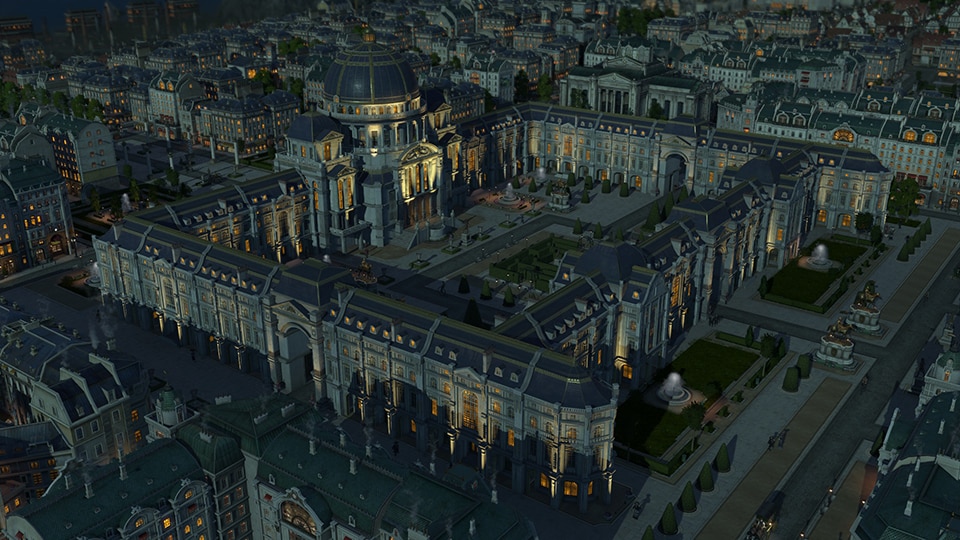The palace is a classic Anno element, and it was first introduced at the start of the franchise in 1998 with Anno 1602. From then on, the palace would represent something to aspire to in several Anno games. As such, the palace is the ultimate projection of a player’s city-building prowess. Now, the palace is ready to make its triumphant return in Anno 1800™, kicking off Season 2 and living up to its predestined role as the Seat of Power.
Flexibility Is Both Majestic and Modular
The first thing Anno 1800 players will notice about the palace is the visual opulence. The palace joins the ranks of the botanical garden, museum, and zoo as Anno 1800’s latest modular building, giving players a lot of freedom to arrange six different modules to their liking such as straight, gate, corner, junction, crossing and end pieces, plus some cosmetic variations on the straight pieces. As with other modular building projects, it all begins with the main building, which a player will unlock once the first investor calls a player’s empire their home (assuming the player can afford the associated significant building cost). Players will also be able to build an initial number of modules based on their company level. As players attract additional citizens and raise their company level, they will unlock the ability to place even more modules. And guess what? There is no hard limit on the number of modules a player can unlock, with one community member reaching more than 130 modules in a recent playtest! Now, before your mind starts drifting off with visions of an all-palace empire, there are some limitations we have to talk about. Namely, players can only build one palace in their empire, and it can only be placed on an Old World island (either the original session or Cape Trelawney from the Sunken Treasures DLC).
Beyond this limitation, players have a lot of flexibility when it comes to building their palace, and we have already seen a variety of impressive setups from our tests, from extravagant gardens to museums and even a world fair constructed within a sprawling palace’s inner courtyard! And of course, both streets and railway tracks can be placed inside the gates to make sure that whatever players want to construct inside the place grounds is properly connected to the rest of their city.
Projecting Your Power, One Buff at a Time
![[AN1800] [News] DevBlog: Seat of Power - Palace Day](http://staticctf.ubisoft.com/J3yJr34U2pZ2Ieem48Dwy9uqj5PNUQTn/4gIfPtBjspPTwGSuvPu7eF/746dfef7ac6189e7ba24faff697b4301/Anno1800_Season2_DLC4_SeatOfPower_Palace-Day.jpg)
But what about those players who don’t care about pretty looks? Let’s talk departments and policies! Once players construct their palace, they immediately gain access to the first two departments, with additional departments unlocking over time as their island increases its attractiveness. So, what do they do? For starters, each unlocked department immediately gives players access to a permanent buff, such as +200 tons islands storage per harbormaster’s office on that island. Each department is specialized on one aspect of the city, such as administration, culture, or transport. In addition – and this is where things get really interesting – each unlocked department gives you a choice of several policies, of which only one can be active at a time. Players can switch them out, though there is a cooldown associated with doing so. This gives players a lot of flexibility to make sure that whatever the situation is on their island, they have full control over the boon they want to use.
![[AN1800] [News] DevBlog: Seat of Power - DLC04](http://staticctf.ubisoft.com/J3yJr34U2pZ2Ieem48Dwy9uqj5PNUQTn/6PEPVkpc1RxpHRWFa5CCyx/ce6c8093033e823d9d292c937317c0f1/DLC04_Screenshot_03.jpg)
Of course, it would not be Anno if there was not also a logistical element. These boons only work in a certain radius around the palace and only along the street network. Though, only the palace main building has to be connected to the streets rather than every module. To bring everything full circle and ensure that future palace builders will have to make some tough choices, the radius of these effects increases with each additional palace module constructed. Do you want a minimal palace to leave as much room as possible for the rest of your city? Or are you looking to construct enough modules to have the effects of policies reach across all of Crown Falls? As always, the choice is yours!
![[AN1800] [News] DevBlog: Seat of Power - DLC04 Night](http://staticctf.ubisoft.com/J3yJr34U2pZ2Ieem48Dwy9uqj5PNUQTn/2nLYFgn0rz1Czes7kF40Up/566ea9dcb0b7a18d4cbbb0f36ead8521/DLC04_Screenshot_04.jpg)
There is one more piece of the palace puzzle, and that is the local departments. They are essentially outposts of the palace that players can construct once per Old World or Cape Trelawney island to select a single policy to enact. Beyond this limitation, local departments follow the same rules as the main palace. They give a passive buff based on the active policy a player selects, and buildings must be both within their radius and connected to the street network to benefit from them. And yes, more palace modules also increase the range of the local departments. Happy city puzzling, everyone!
Start Ruling on March 24
Seat of Power combines a lot of flexibility for building the modular palace of your dreams with some tough choices when it comes to which buff to select for which island and local department. On top of that, you can prove your mastery with five new achievements and two new sets of ornaments players can unlock with the Ubisoft Club. Players can start constructing the Seat of Power when the first DLC of Season 2 becomes available on March 24 for all Season 2 Pass owners. Starting on that day, you can also buy the DLC individually for $9.99 or your local equivalent. However, please note that due to the current government advisory on the Covid-19 pandemic, we will have to skip our traditional release stream for Seat of Power. As always, keep an eye on the Anno Union for the latest news and updates on the game!

